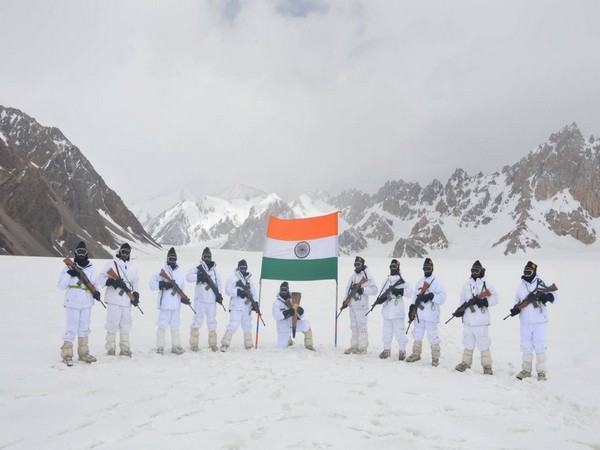
Resolving Siachen Dispute Amid LAC Standoff with China

India and Pakistan got independence in August 1947 in compliance with Independence Act 1947 passed in UK Parliament on 18 July 1947. The terms and conditions set forth for integration of princely states created their own challenges of being part of India/Pakistan. The delayed decision of Maharaja Hari Singh of J&K State resulted in Pakistan launching armed intervention for the capture of entire J&K, but the same was thwarted by India as Maharaja Hari Singh signed instrument of accession to India on 27 October 1947 and thus the entire state of J&K became integral part of India.
Indian forces intervened and pushed back Pakistani raiders. The first conflict of India-Pakistan commenced and continued through 1947-48. Cease fire was agreed between both the countries later resulting in almost 45 percent of J&K area under illegal occupation of Pakistan. Karachi Agreement was signed on 27 July 1949 and Cease Fire Line (CFL) was delineated between India and Pakistan without affecting the mutual claims. This line moved till the point at NJ 9842 being the northern most edge and it was not delineated further due to glaciated uninhabited terrain and left at ‘NJ 9842 and thence northwards.’
Non delineation of CFL till the end of glaciated region is the primary cause of Siachen conflict, the highest battlefield of the world and causing large number of casualties on both sides due to terrain and weather conditions and much less due to adversarial actions.
Despite unprecedented win in 1971, the delineation of LOC between India and Pakistan post agreement of 1972 also terminated at NJ 9842, as its Northernmost point, without delineating it further. India interprets the line moving along the Saltaro Ridge beyond NJ 9842 in sync with international practice of drawing the borders whereas Pakistan interprets it as a line to be drawn North and thus the dispute. While this area did not come under active clashes either in 1965 or in 1971, Pakistan started attempting cartographic aggression as well as granting permission to foreign mountaineering expeditions in the Siachen glacier to fortify its claims in these areas, but this was negated by Indian action wherein it launched Operation Meghdoot on 13 April 1984 and occupied the entire Siachen glacier which continues under its possession till date despite multiple Pakistani attempts to capture its part.
Indian stakes in Siachen glacier are not only limited to physical possession of this glacier and to keep Pakistan away from its occupation, but its importance also has strategic dimensions which will be evident from the following facts:
Pakistan has been leveraging China since its independence. Having failed in its ultimate aim of annexing J&K by force, it entered into collusivity with China. When India lost 1962 war with China, Pakistan illegally ceded Shaksgam valley of POK to China in 1963 which is located North of Siachen glacier. It facilitated physical link up between both the nations.
China has already constructed Karakorum Highway known as NH 314 in China besides also as part of Asia Highway AH4. This connectivity is providing China the option to move its energy resource through the shortened land route while Pakistan will also be benefitted in the mobilization of military equipment being sourced from China. The Siachen occupation therefore provides an excellent geo-platform to keep surveillance on this collusivity and prevent further expansion of this link up which is strategically needed to preserve the Indian interest.
By ceding Sakshgam valley to China in 1963, getting operationalization of Karakorum Highway, being part of Chinese BRI and CPEC, Pakistan has already succeeded in getting China into Indo-Pak conflict. There are too huge strategic, operational and economic commitment by China into POK that it cannot sit back in any future conflict between India and Pakistan across current day LOC, more so in the areas of Gilgit-Baltistan.
The geographical linkages combined with national interest of China and Pakistan have reached to a level wherein India should not look at it as two borders with collusive support but one border, which could be named as Chinapak (Chi-Napak) border. The challenges of this border will enhance manifold if any concession is offered to Pakistan in Siachen glacier unless entire J&K issue is settled.
Though there are some other important reasons as well which are well served with Siachen glacier being under physical occupation of India. These include having control over source of water for Nubra River, monitoring Chinese activities and having some effect on physical collusivity of two nuclear capable states.
Multiple attempts were made to resolve this dispute including this being also listed as part of composite dialogue process decided in 1992. The sixth round of mutual discussion held at New Delhi from 2-6 November 1992 almost succeeded in resolving the issue. India was willing for withdrawal of troops from the Siachen glacier as was also agreed by Pakistan, but India sought accepting current troop’ locations marked on the map. Initially hesitant, but Pakistan accepted the Indian demand to authenticate the troop’ location albeit on the annexure to be attached with the main document of the planned agreement. The agreement was not signed due to domestic considerations brewing up at that time.
It goes to the credit of Indian leadership to come close to such an agreement despite Pakistan unleashing terror in the state of J&K since 1990. The Siachen issue was discussed again for the resolution in 2005 but Pakistan was not agreeing on authenticating the ground position held by Indian troops.
Indian COAS during a press interaction on 12 January 22 prior to Army Day reiterated Indian willingness to examine the resolution of Siachen dispute if Pakistan signs the agreement with acceptance of Indian physical locations on the Glacier. It is interesting that it was not positively responded by Pakistan but the current developments with China prohibit any settlement with Pakistan unless part of overall boundary settlement as its non-occupation by India will affect national interests of India adversely. The following aspects need to be looked into:
*Continuing standoff at LAC with China since Apr-May 20 and non-resolution despite 16 rounds of military level conferences.
*Rigidity of China on Depsang plains with hidden agenda of expanding geo linkages between itself, its roads and Pakistan.
- *Planning of G695 highway in the area along with other infrastructure development.
*Emboldened connectivity between China and POK wherein Pakistan may lease certain areas of POK to China furthering CPEC related activities.
It is therefore essential that India preserve its national strategic interest by continued physical occupation of Siachen glacier unless the border issue is settled with Pakistan in totality. Withdrawal of troops even if Pakistan signs the agreement by authenticating the current locations is not a pragmatic option at this stage as it can negate the agreement once we withdraw on the similar lines as has been done by its all-weather friend China disregarding all agreements with India and undertaking incursions across LAC in Eastern Ladakh.
**********
Disclaimer
The opinions expressed in this article are the author’s own and do not reflect the views of Chanakya Forum. All information provided in this article including timeliness, completeness, accuracy, suitability or validity of information referenced therein, is the sole responsibility of the author. www.chanakyaforum.com does not assume any responsibility for the same.
Chanakya Forum is now on . Click here to join our channel (@ChanakyaForum) and stay updated with the latest headlines and articles.
Important
We work round the clock to bring you the finest articles and updates from around the world. There is a team that works tirelessly to ensure that you have a seamless reading experience. But all this costs money. Please support us so that we keep doing what we do best. Happy Reading
Support Us





















POST COMMENTS (1)
Kalidan Singh